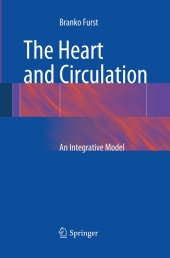 Neuerscheinungen 2015Stand: 2020-02-01 |
Schnellsuche
ISBN/Stichwort/Autor
|
Herderstraße 10
10625 Berlin
Tel.: 030 315 714 16
Fax 030 315 714 14
info@buchspektrum.de |

Branko Furst
The Heart and Circulation
An Integrative Model
Softcover reprint of the original 1st ed. 2014. 2015. xxix, 226 S. 235 mm
Verlag/Jahr: SPRINGER, BERLIN; SPRINGER, LONDON; SPRINGER 2015
ISBN: 1-447-15952-7 (1447159527)
Neue ISBN: 978-1-447-15952-0 (9781447159520)
Preis und Lieferzeit: Bitte klicken
This book traces the development of the basic concepts in cardiovascular physiology in the light of the accumulated experimental and clinical evidence and, rather than making the findings fit the standard pressure-propulsion mold, let the phenomena ´speak for themselves´. It starts by considering the early embryonic circulation, where blood passes through the valveless tube heart at a rate that surpasses the contractions of its walls, suggesting that the blood is not propelled by the heart, but possesses its own motive force, tightly coupled to the metabolic demands of the tissues. Rather than being an organ of propulsion, the heart, on the contrary, serves as a damming-up organ, generating pressure by rhythmically impeding the flow of blood. The validity of this model is then confirmed by comparing the key developmental stages of the cardiovascular system in the invertebrates, the insects and across the vertebrate taxa. The salient morphological and histological features of the myocardium are reviewed with particular reference to the vortex. The complex, energy-dissipating intracardiac flow-patterns likewise suggest that the heart functions as an organ of impedance, whose energy consumption closely matches the generated pressure, but not its throughput. Attention is then turned to the regulation of cardiac output and to the arguments advanced by proponents of the ´left ventricular´ and of the ´venous return´ models of circulation. Hyperdynamic states occurring in arteriovenous fistulas and congenital heart defects, where communication exists between the systemic and pulmonary circuits at the level of atria or the ventricles, demonstrate that, once the heart is unable to impede the flow of blood, reactive changes occur in the pulmonary and systemic circulations, leading to pulmonary hypertension and Eisenmenger syndrome. Finally, the key points of the nook are summarized in the context of blood as a ´liquid organ´ with autonomous movement.
PART I - Early Embryo Circulation.- Introduction.- Early Embryo Circulation - Morphologic Features.- The Onset of Circulation.- Hemodynamics of the Early Embryo Circulation.- Flow Patterns in the Early Embryo Circulation.- Heart Vortex Formation.- Is There a Circulation Without a Heart? .- Embryo Heart is not a Peristaltic Pump.- Flow Perturbation Experiments.- Heart Rate Perturbations.- The Heart as Generator of Pressure.- Ventriculo-Vascular Interaction.- A Brief Comparative Phylogeny.- Evolutionary Aspect of the Rhythmical System.- PART II - Mature Circulation.- Functional Morphology of the Heart.- Regulation of Cardiac Output.- Models of the Heart.- Cardiovascular Response during Exercise.- Hemodynamic Effects of Aortic Occlusion.- Increased Pulmonary Flows.- Single Ventricle Physiology.- Blood as an Organ.
"Dr. Furst has commendably reviewed the origin and historical development of the heart-as-a-pump concept and amassed, as well, a very considerable weight of evidence undermining it and supporting an alternative model of the heart as an organ of impedance. This book will be particularly well received by all those who, like myself, experience a growing lack of confidence in the cardiocentric model of circulation. ... I recommend this book to all open-minded cardiovascular physiology enthusiasts without reservation ... ." (Anthony M. O´Leary, Anesthesiology, Vol. 124 (4), April, 2016)
"With this monograph Branko Furst succeeded to lay a foundation for a new physiology of the cardiovascular system. His excellent overview and presentation of a wide selection of topics is presented with clarity and depth of knowledge. ... this book will serve as a basis for a more encompassing, specifically human cardiovascular physiology arising from the evolutionary-biologic model of circulation." (Original book review in German language, Hans Christoph Kümmell, Der Merkurstab, Vol. 67 (3), 2014)


